
COPYRIGHT © NOVEMBER, 2008 BY GRIZZLY INDUSTRIAL, INC. REVISED APRIL, 2019 (JL).
WARNING: NO PORTION OF THIS MANUAL MAY BE REPRODUCED IN ANY SHAPE
OR FORM WITHOUT THE WRITTEN APPROVAL OF GRIZZLY INDUSTRIAL, INC.
#TR11336 PRINTED IN USA
MODEL H0627/H0628
ZERO-CLEARANCE
TABLE INSERT
INSTRUCTIONS
If you need help with your new insert, call our Tech Support at: (570) 546-9663.
Important Considerations
CARBIDE BLADES: Only recommended for use with
carbide tipped blades
DEDICATED INSERTS: Ideally, a separate insert
should be used with each blade, dado stack, or
angle set-up. This will ensure a true “zero-clear-
ance” effect and give you maximum benefit from
your table inserts.
SPLITTER/RIVING KNIFE: If this insert is to be used
with a splitter or riving knife, you will need to fin-
ish cutting out the pre-routed optional splitter slot,
using a saw or router. Break any leftover sharp
edges with sandpaper.
FINGER HOLE: Before fitting the insert, consider
drilling a finger hole near the front of the insert
to make it easier to remove after installation; oth-
erwise, a snug fitting table insert may be difficult
to pull out.
DADO BLADE: Use extreme caution when cutting
the blade slot (kerf) by moving the blade much
slower than otherwise due to the substantial cut-
ting forces from the wide dado blade.
Installing and Fitting Your Insert
1. Lower the blade completely.
2. Place the insert in the throat opening, back end
first, so that the anti-lift lug engages under the rear
edge of the table top. Initially, the insert should be
too long and hit on the front "fitting bumps."
3. Using a medium grit sanding block, lightly sand all
four bumps. While sanding, slightly bevel the bot-
tom edges of the front bumps to ease entry. Once
the table insert has a tight wedge fit, only sand the
front bumps. Sand, test-fit, and repeat to gradually
“sneak-up” on a snug, yet easily removable fit.
4. Adjust the four leveling screws until the insert is
stable and is flush with the tabletop.
Cutting the Blade Slot (Kerf)
1. Check that the insert is fitted properly and that the
blade is NOT touching the insert. To check the
blade clearance, you can rotate the blade from
below using a stick or by moving the belt.
2. Place a scrap board over the top of the table
insert and firmly clamp the board to the table at
both ends, so the table insert will not lift when you
raise the blade into it during the next step.
3. Re-connect the saw to power. KEEP HANDS
OFF OF TABLE TOP, DON'T STAND DIRECTLY
BEHIND THE BLADE PATH, AND WEAR EYE
PROTECTION. Switch the saw ON, then slowly
and cautiously raise the blade up to its maximum
height to cut through the insert.
4. Lower the blade completely, turn the saw OFF,
then remove the clamping board. The insert is
now ready for use!
Note: Under certain conditions, an undesirable
scraping noise may be generated by excessive
arbor run-out or blade distortion causing the blade
body to intermittently contact the insert slot. To
remedy this, remove the insert and slightly widen
the slot, using a file or sanding paddle.
• Disconnect saw from power before fitting
or removing table insert!
• Always wear eye protection.
• Do not tilt the blade while it is in the insert!
For beveled cuts, a separate insert must
be used with the blade slot (kerf) cut only
at that angle.
• Insert must be securely clamped down
with a board before plunging the blade
up through it to cut the kerf.
• If using a blade stabilizer, check the
clearance before raising the blade.
-
 1
1
Grizzly H0628 Owner's manual
- Type
- Owner's manual
- This manual is also suitable for
Ask a question and I''ll find the answer in the document
Finding information in a document is now easier with AI
Related papers
Other documents
-
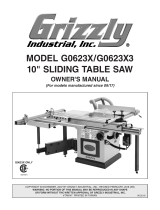 Grizzly Industrial G0623X User manual
Grizzly Industrial G0623X User manual
-
RIDGID R4516 User manual
-
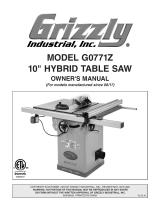 Grizzly Industrial G0771Z User manual
Grizzly Industrial G0771Z User manual
-
Powermatic 2000NCI: No Clearance Insert for PM2000 User manual
-
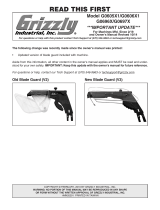 Grizzly Industrial G0605X1 User manual
Grizzly Industrial G0605X1 User manual
-
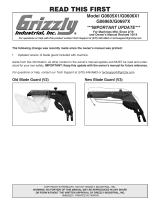 Grizzly Industrial G0697X User guide
Grizzly Industrial G0697X User guide
-
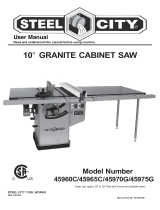 Steel City 45975G-I36 User manual
Steel City 45975G-I36 User manual
-
Woodstock D3614 User manual
-
Steel City 35904 User manual





